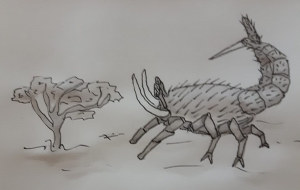Difference between revisions of "Wesköpa"
From World of Entorais Wiki
Jump to navigationJump to search (applied template) |
(content) |
||
| Line 1: | Line 1: | ||
[[File:wesköpa.png|thumb|right|100x|Wesköpa - "Sebastian Romu" © 2019]] | |||
==About== | ==About== | ||
;Common Names: | ;Common Names:Wesköpa, ''Tusked Crabs'', ''Tundra Crabs'' | ||
;Classification: | ;Classification:Arthropod | ||
==Description== | ==Description== | ||
;Size: < | ;Size: < 55kg kg (<--number--> pounds), < 1 meter ( 3 feet, 4 inches) body length, < 1 meters (3 feet, 4 inches) tail length. | ||
;Appearance: | ;Appearance: Large ovoid bodied crustaceans, with a pair of stalked eyes, long tusk-like projections, a pair of fore-limbs ending in blunted scoops, two pairs of long legs with pincer appendages, and a shorter pair with similar pincers on their hindmost legs. They also posses a long pair of articulated tails. Their shells are covered with bristle-like hairs. | ||
;Sexual Dimorphism: | ;Sexual Dimorphism: The left tail of males is tipped with a large spike used in sparring, mating displays, and sexual coupling. | ||
;Variance: | ;Variance: No notable sub-species. | ||
==Ecology== | ==Ecology== | ||
;Habitat: | ;Habitat:Amphibious, Saltwater, tundra and gravel-beaches of northern subarctic to arctic latitudes. | ||
;Diet: | ;Diet:Wesköpa are carnivores whom prey upon shellfish, crustaceans, and other burrowing animals which they dig up using their shovel-like fore-limbs. | ||
==Behaviour== | ==Behaviour== | ||
;Social Grouping: | ;Social Grouping:Solitary as adults, small groups related young less than 2 years of age. | ||
;Temperament: | ;Temperament:Friendly, will approach animals of all sorts. | ||
;Intelligence: | ;Intelligence:Animal. | ||
;Reproduction: | ;Reproduction:Live births 7-8 young annually. | ||
==Sub-Species== | ==Sub-Species== | ||
: | :None | ||
==Domestication== | ==Domestication== | ||
;General: | ;General:none | ||
;Resources: | ;Resources:meat, ivory, and shells. | ||
==Stories== | ==Stories== | ||
| Line 36: | Line 34: | ||
:<!--links to related material--> | :<!--links to related material--> | ||
[[Category:Arthropod]] | [[Category:Arthropod]] | ||
[[Category:Fauna]] | [[Category:Fauna]] | ||
Revision as of 15:15, 8 July 2020
About
- Common Names
- Wesköpa, Tusked Crabs, Tundra Crabs
- Classification
- Arthropod
Description
- Size
- < 55kg kg (<--number--> pounds), < 1 meter ( 3 feet, 4 inches) body length, < 1 meters (3 feet, 4 inches) tail length.
- Appearance
- Large ovoid bodied crustaceans, with a pair of stalked eyes, long tusk-like projections, a pair of fore-limbs ending in blunted scoops, two pairs of long legs with pincer appendages, and a shorter pair with similar pincers on their hindmost legs. They also posses a long pair of articulated tails. Their shells are covered with bristle-like hairs.
- Sexual Dimorphism
- The left tail of males is tipped with a large spike used in sparring, mating displays, and sexual coupling.
- Variance
- No notable sub-species.
Ecology
- Habitat
- Amphibious, Saltwater, tundra and gravel-beaches of northern subarctic to arctic latitudes.
- Diet
- Wesköpa are carnivores whom prey upon shellfish, crustaceans, and other burrowing animals which they dig up using their shovel-like fore-limbs.
Behaviour
- Social Grouping
- Solitary as adults, small groups related young less than 2 years of age.
- Temperament
- Friendly, will approach animals of all sorts.
- Intelligence
- Animal.
- Reproduction
- Live births 7-8 young annually.
Sub-Species
- None
Domestication
- General
- none
- Resources
- meat, ivory, and shells.
